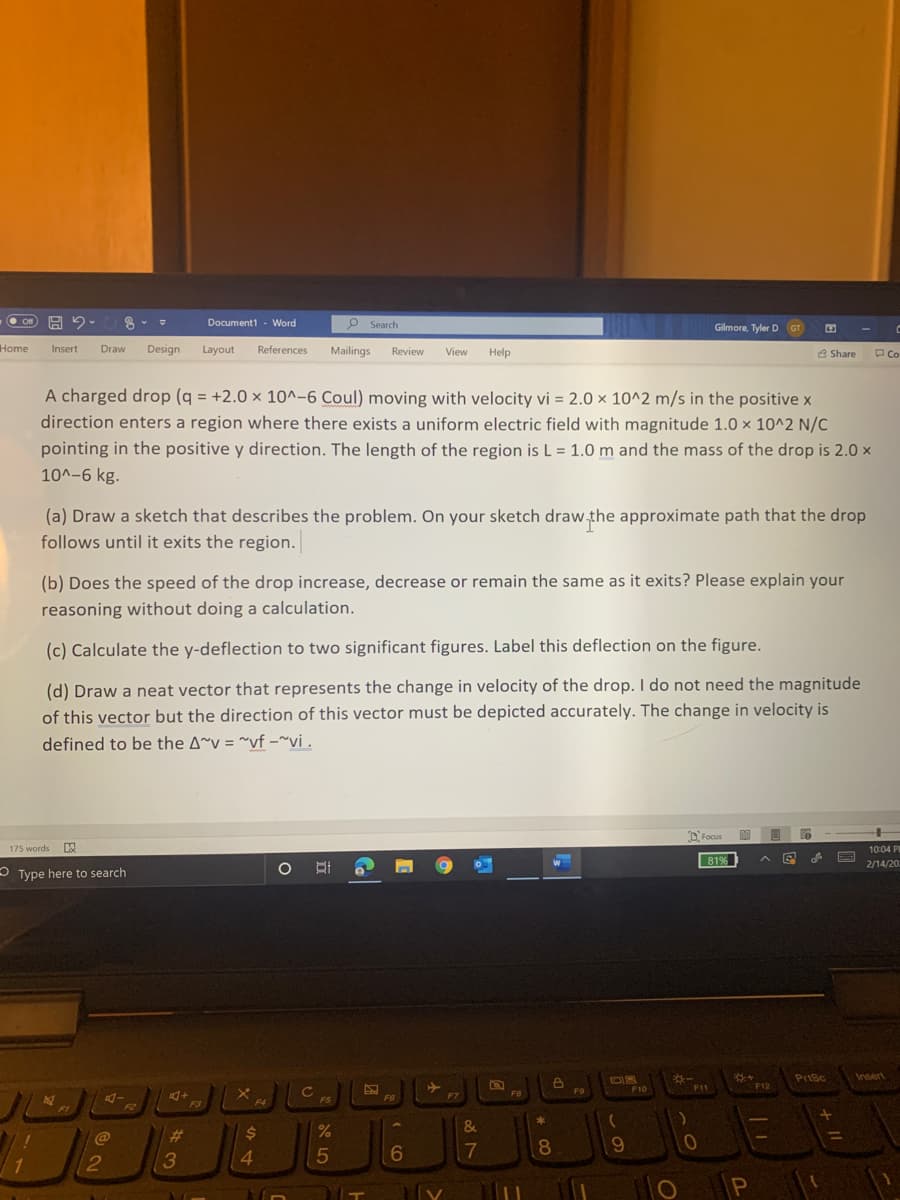A charged drop (q = +2.0 x 10^-6 Coul) moving with velocity vi = 2.0 x 10^2 m/s in the positive x direction enters a region where there exists a uniform electric field with magnitude 1.0 x 10^2 N/C pointing in the positive y direction. The length of the region is L = 1.0 m and the mass of the drop is 2.0 x 10A-6 kg. %3D (a) Draw a sketch that describes the problem. On your sketch draw the approximate path that the drop follows until it exits the region. (b) Does the speed of the drop increase, decrease or remain the same as it exits? Please explain your reasoning without doing a calculation. (c) Calculate the y-deflection to two significant figures. Label this deflection on the figure. (d) Draw a neat vector that represents the change in velocity of the drop. I do not need the magnitude of this vector but the direction of this vector must be depicted accurately. The change in velocity is defined to be the AV = "vf -~vi.
A charged drop (q = +2.0 x 10^-6 Coul) moving with velocity vi = 2.0 x 10^2 m/s in the positive x direction enters a region where there exists a uniform electric field with magnitude 1.0 x 10^2 N/C pointing in the positive y direction. The length of the region is L = 1.0 m and the mass of the drop is 2.0 x 10A-6 kg. %3D (a) Draw a sketch that describes the problem. On your sketch draw the approximate path that the drop follows until it exits the region. (b) Does the speed of the drop increase, decrease or remain the same as it exits? Please explain your reasoning without doing a calculation. (c) Calculate the y-deflection to two significant figures. Label this deflection on the figure. (d) Draw a neat vector that represents the change in velocity of the drop. I do not need the magnitude of this vector but the direction of this vector must be depicted accurately. The change in velocity is defined to be the AV = "vf -~vi.
College Physics
1st Edition
ISBN:9781938168000
Author:Paul Peter Urone, Roger Hinrichs
Publisher:Paul Peter Urone, Roger Hinrichs
Chapter18: Electric Charge And Electric Field
Section: Chapter Questions
Problem 53PE: A simple and common technique for accelerating electrons is shown in Figure 18.55, where there is a...
Related questions
Question

Transcribed Image Text:80 G E
Design
Layout
O on
Document1 - Word
P Search
Gilmore, Tyler D GT
Home
Insert
Draw
References
Mailings
Review
View
Help
3 Share
PCo
A charged drop (q = +2.0 × 10^-6 Coul) moving with velocity vi = 2.0 × 10^2 m/s in the positive x
direction enters a region where there exists a uniform electric field with magnitude 1.0 × 10^2 N/C
%3D
%3D
pointing in the positive y direction. The length of the region is L = 1.0 m and the mass of the drop is 2.0 x
10^-6 kg.
(a) Draw a sketch that describes the problem. On your sketch draw the approximate path that the drop
follows until it exits the region.
(b) Does the speed of the drop increase, decrease or remain the same as it exits? Please explain your
reasoning without doing a calculation.
(c) Calculate the y-deflection to two significant figures. Label this deflection on the figure.
(d) Draw a neat vector that represents the change in velocity of the drop. I do not need the magnitude
of this vector but the direction of this vector must be depicted accurately. The change in velocity is
defined to be the A^v = ^vf –~vi .
O Focus
175 words
10:04 PE
81%
O BI
2/14/20
- Type here to search
Prisc
Insert
F10
F11
F12
F8
F9
F6
F7
F3
F4
F5
F1
F2
&
@
23
24
6
17
8.
9.
2
3
4.
P
Expert Solution
Step 1
Since you have posted a question with four subparts, we will solve first three only as per our guideline. Please resubmit the question for the fourth part.
Given:
Step by step
Solved in 4 steps with 1 images

Knowledge Booster
Learn more about
Need a deep-dive on the concept behind this application? Look no further. Learn more about this topic, physics and related others by exploring similar questions and additional content below.Recommended textbooks for you

College Physics
Physics
ISBN:
9781938168000
Author:
Paul Peter Urone, Roger Hinrichs
Publisher:
OpenStax College

Physics for Scientists and Engineers, Technology …
Physics
ISBN:
9781305116399
Author:
Raymond A. Serway, John W. Jewett
Publisher:
Cengage Learning

College Physics
Physics
ISBN:
9781305952300
Author:
Raymond A. Serway, Chris Vuille
Publisher:
Cengage Learning

College Physics
Physics
ISBN:
9781938168000
Author:
Paul Peter Urone, Roger Hinrichs
Publisher:
OpenStax College

Physics for Scientists and Engineers, Technology …
Physics
ISBN:
9781305116399
Author:
Raymond A. Serway, John W. Jewett
Publisher:
Cengage Learning

College Physics
Physics
ISBN:
9781305952300
Author:
Raymond A. Serway, Chris Vuille
Publisher:
Cengage Learning

College Physics
Physics
ISBN:
9781285737027
Author:
Raymond A. Serway, Chris Vuille
Publisher:
Cengage Learning

Physics for Scientists and Engineers with Modern …
Physics
ISBN:
9781337553292
Author:
Raymond A. Serway, John W. Jewett
Publisher:
Cengage Learning

Physics for Scientists and Engineers
Physics
ISBN:
9781337553278
Author:
Raymond A. Serway, John W. Jewett
Publisher:
Cengage Learning